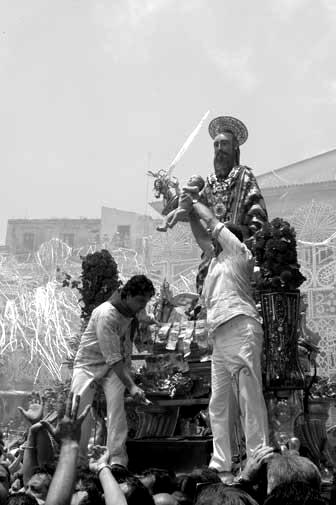
Italian Boys' Clothes: Folk Festivals

Figure 1.--Many are religious in character and are commonly associated with the patron saint of the village. An Italian reader tells us about the festival of Saint Paulís in Palazzolo Acreide, a large village in Sicily. It is in the south-western part of the island.
|
|
Every Italian town and village has their own destinctive festivals. A range of cultural elements are involved, including often destinctive clothing. Many are religious in character and are commonly associated with the patron saint of the village. These festivals have develoed during Itakly;s long history. Many date back to the middle ages. In some cases they may have had ancienr routes as the Church often coopted pagan festivals and traditiions. In these days before mobvies, radio, and teklevision, these festivals were an important part of the cuktural life of towns and villags. Many have continued in the modern age as cherished traditions.
An Italian reader tells us about the festival of Saint Salvatore at Cabras. This is a village located along the eastern coast of Sardinia. Here we see the festival which takes place on the first weekend of September each year. The festival is called "Corsa degli scalzi" (i.e. barefoot people's run). On Saturday many young people and boys begin running the statue of Saint Salvatore in the village church to a little church in the country. I'm no sure why they go to thich country church. On Sunday they bring back the statue. The young people and boys wear a white smock and go barefoot. The festival's origin is not known with any surity, but the barefoot people's run is an ancient tradition of Cabras inhabitants. Some legends attempt to explain the origin and the meaning of bare feet. We must remember, however, that Cabras was a fishing village and until the early 1900s inhabitants went barefoot all year round.
Festival of Saint Paulís in Palazzolo Acreide (Sicily)
An Italian reader tells us about the Festival of Saint Paulís in Palazzolo Acreide, a large village in Sicily (figure 1). It is in the south-western part of the island. The most important aspect of the festival is the procession. At 1:00 p.m. of June 29, the statue of the saint (made by a local sculptor in 1507) is brought out of the church through the main door. The statue is carried on the shoulder by many people along the village streets. Some barefoot women follow the statue. During the procession many mothers undress their little children. The children are then brought as near as possible to the saintís statue. It is a sign of instance of protection by the saint that probably has a pre-Christian origin. We find this rite in some other Sicilian festivities."
Pacentro, a little village in the mountains, about 150 km east of Rome, in the region Abruzzo.
The Patron feast of the village is celebrated on September 8, for the Catholic Church feast of the Nativity of Mary.
During the feast takes place a boys' race called "Corsa degli Zingarelli" (Little Gypsies' Race). In the local dialect, however, the word Zingaro means Barefoot. In the region Abruzzo, indeed, there is an ancient settlement of Gypsies (Rom), that traditionally went barefoot. An Italian reader tells us, "This is a barefoot race throughout the village streets, but it is not only a sport contest. The race is joined to the religious feast, so it starts from the church and finishes into the church. The winners of the races have a little prize, but, for all the runners, the most important thing is to get to the finish. Sometimes the children have some feet wounds, but their parents don't stop them: on the contrary, the parents encourage them to continue the race."
HBC

Navigate the Boys' Historical Clothing Italian pages:
[Return to the Main Italian activities page]
[Return to the Main Itlalian page]
[Return to the Main religion page]
[Italian school uniforms]
[Italian youth groups]
[Italian choirs]
[Italian movies]
[Italian royalty]
Navigate the Boys' Historical Clothing Web Site:
[Introduction]
[Activities]
[Biographies]
[Chronology]
[Clothing styles]
[Countries]
[Bibliographies]
[Contributions]
[FAQs]
[Glossaries]
[Glossary]
[Images]
[Links]
[Registration]
[Tools]
[Boys' Clothing Home]
Created: 1:44 AM 11/23/2005
Last updated: 12:17 AM 11/7/2013



